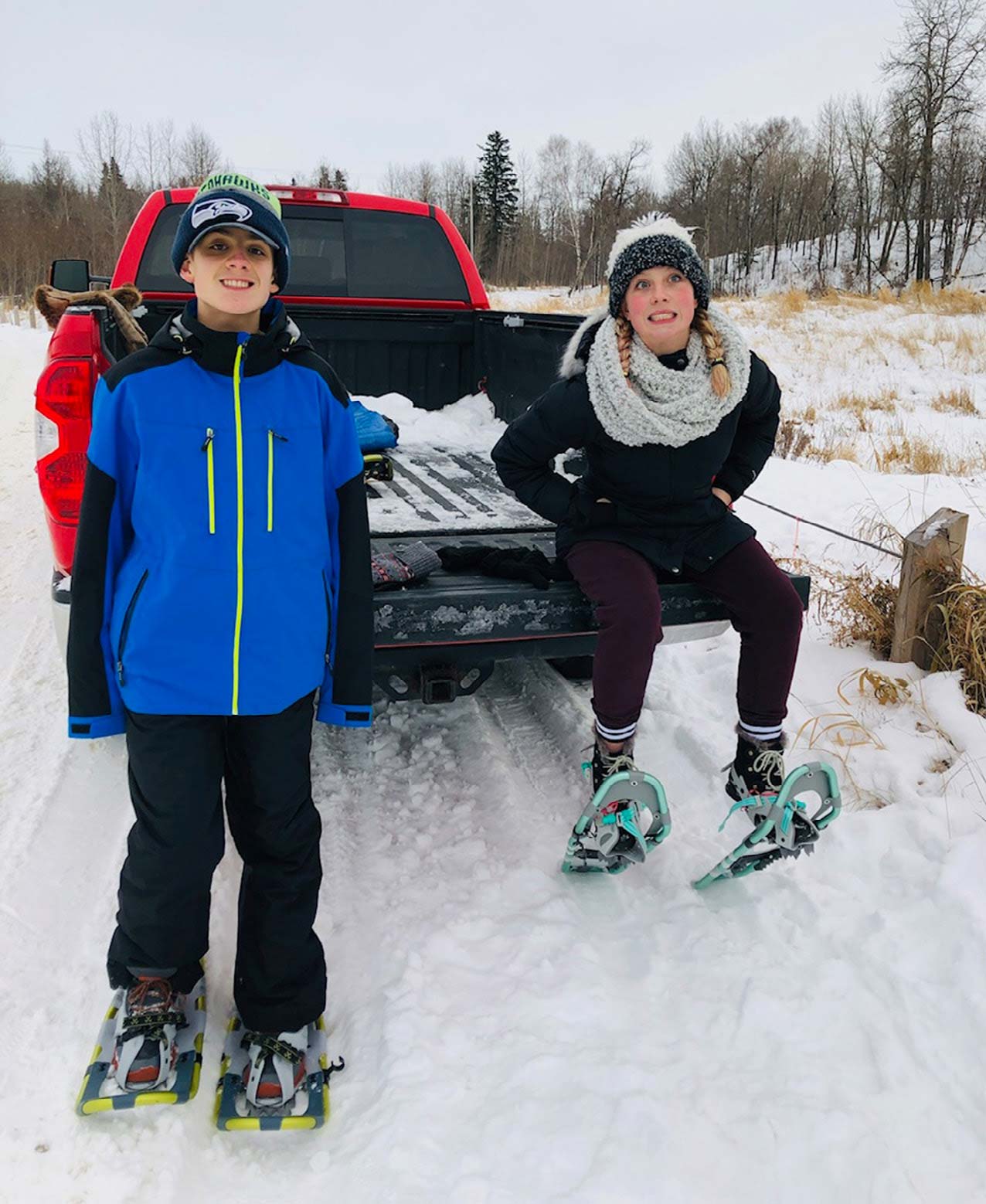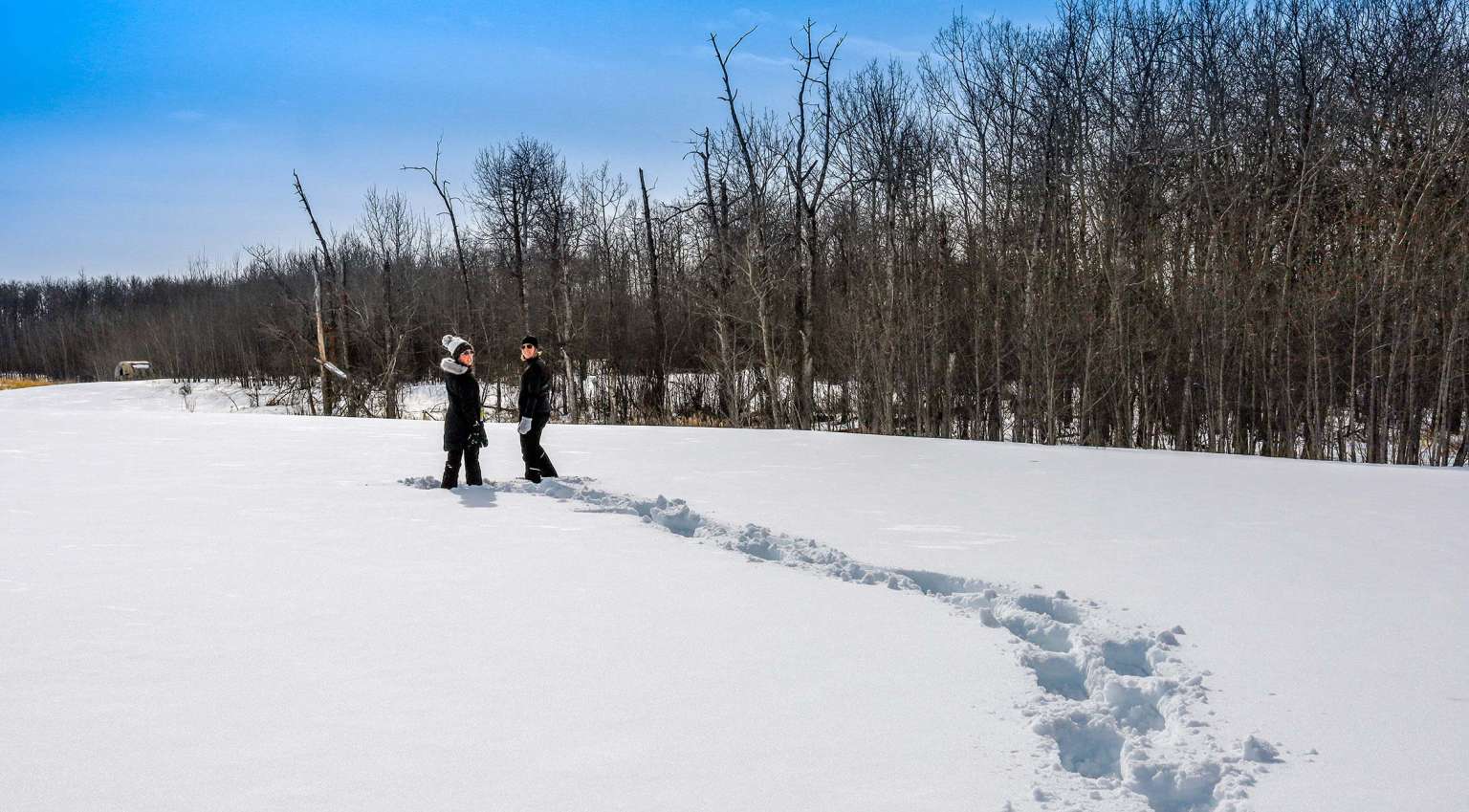
Perhaps it’s your New Year’s resolution to try something new as a family. Perhaps you’ve thought about getting more active this year or at least doing so during the winter months. Perhaps you’ve seen something in your news feed that has you thinking about increasing your healthy lifestyle this winter.
Whatever the reason, snowshoeing is a fun and inexpensive recreational winter family-friendly activity that’s quite easy to learn in the appropriate conditions. According to recent retail sales data, snowshoe sales have grown more than 250% year – over – year in North America. Specifically, for outdoor retailer Cabelas, sales of snowshoes are up four-fold from pre-COVID-19 pandemic times, and the stores are having a tough time keeping equipment in stock.
Snowshoeing is exploding in popularity because of its easy learning curve and affordability. This sport doesn’t require lessons or an expensive lift ticket. Simply strap on a pair of snowshoes and go for a hike as you would any other time of year. The trick is to stay afloat on the snow. Snowshoes are specialized outdoor gear for walking over deep snow. Their large footprint spreads the user’s weight out and allows them to travel largely on top of snow rather than through snow that is knee-deep. Adjustable bindings attach the shoes to appropriate winter footwear.
Historically, snowshoes were used by anyone dependent on traveling across deep snow in areas, or eras, without motorized vehicles. Fur traders and trappers used them frequently. Snowshoes were made primarily with hardwood frames filled in with rawhide latticework and were commonly shaped as a teardrop. Tied to your winter boots, they required that you walk with a consistent stride to avoid stepping on them. Today’s modern snowshoes are made of lightweight metal, plastic, and other synthetic materials. They are more rectangular in shape and are easier to walk with. They include adjustable bindings to attach them to appropriate winter footwear. Today, their greatest contemporary use is for recreation, including trapping.
According to Snowsports Industries of America, the sport of snowshoeing burns more than 600 calories per hour and maintains or improves cardiovascular fitness. Snowshoeing is a low-impact activity for those with any injuries or other health issues. However, these days, one of the best cases for getting into snowshoeing is your mental health. Today’s fast-paced, convenience-focused lifestyle means we’re spending more and more time on screens and electronics—rather than outdoors.
Snowshoe outings can be tailored to match the ability and age of anyone willing to participate in the sport. Leisurely walks in the park, casual jaunts in protected parks, or steep grueling climbs in the backcountry are all possible, both near to, or far from your home. Either way, you need appropriate gear to make outings safe and enjoyable.
Get Good Gear
First and foremost, you’ll need winter clothing from head to toe. Dressing in layers is always advisable. Avoid putting cotton next to your skin. Cotton is soft and comfortable and better saved for after your outing to lounge by the fire with a warm cup of your favorite hot winter drink. Base layers should be moisture-wicking and should retain their insulating value when damp or wet from sweat. Wool provides moisture-wicking qualities and warmth all in one, but there are several high-tech synthetic garments that also work well.
Pay close attention to your extremities when snowshoeing—your hands, feet, and head. We wear a small skin-tight glove inside a bigger waterproof mitt. This allows us to keep our hands warm and free from snow while allowing us to still use the inner dexterity of our fingers when needed, such as taking pictures or tightening the buckles on our snowshoes.
I personally like the inner gloves that allow you to use the touchscreen on your smartphone, since that’s the camera I usually use these days. Wool socks are a must inside your insulated winter boots, too. How much you sweat and how insulated your boots are will determine the thickness of your sock. A beanie is also necessary to keep your head warm. Once you start moving, you can get hot, so removing your beanie is an easy way to control your temperature. Just make sure you put it back on when you stop for a break.
Poles are nice to have, but not necessary. They help with balance and make crossing perpendicular slopes easier. Similar to trekking poles, they also take some weight off your knees and keep your arms moving more to generate heat and stay warm. You can purchase or rent specific snowshoeing poles, but you can also use ski poles or trekking poles. When using trekking poles, replace the standard baskets near the bottom with larger snow baskets to improve floatation and performance in deep snow.
Of course, you need snowshoes. Newer snowshoes are easy to strap into and adjust to your boots, and they are comfortable to walk in. Make sure your winter boots fit right into the binding so that the pad of your foot is directly on top of the cleat or crampon. Bindings are crucial because they keep the snowshoe connected to your foot. Ratchet-type bindings (similar to snowboards) are easy to use with mitts, and then to adjust as needed, but you want to make sure your snowshoes are rated for the temperature you’ll be using them in. Some rubber and plastic, which are common materials used in binding construction, can become brittle and break easily in deep freeze weather. You don’t want that to happen.
Importance of Sizing
Sizing your snowshoe is most important. First and foremost, you need to consider your weight. The heavier you are, the larger your frame, thus the degree of deck material required to keep you atop the snow. All snowshoes will have a sizing guide on the packaging, so be sure to read it thoroughly.
Don’t forget to add in the weight of the gear you’ll be wearing or carrying along with you. Your winter snow gear and boots will add an additional 10 to 15 pounds, and even more once these are damp. A pack with lunch weighs another 10 pounds, so you’ll want a bigger snowshoe to accommodate the added weight.
Some snowshoes have an outer frame constructed of aluminum and then deck material filling the center of the frame. Others are constructed entirely of plastic. Both work well, and it’s a matter of personal preference and budget. Not all snowshoes will have a heel lift, but most do. Some even allow you to lock them in various positions to give your calves an easier time, depending on whether you’re ascending, descending, or moving across an open flat prairie.
Essential to Remember
Finally, bring a small pack with survival gear. Accidents happen and you need to be prepared for winter survival. At the very least, include an emergency blanket, waterproof matches, fire starter, and some wire for building a shelter. I also like to carry food and water, a first aid kit, a folding saw, a knife, a parachute cord, a headlamp, hand warmers, and a GPS. A parachute cord can be very handy if you have a snowshoe binding that breaks. It can make the difference between getting back without them.
Technique Matters
The whole point of snowshoes is that you don’t sink knee-deep into the snow but instead get to “float” over the snow. It’s normal if you sink into the snow a little bit, but the shoes provide floatation by distributing your weight over a wider surface area that makes it easier to take each step.
Secondly, you’ll need to think about traction, and not slide on top of the snow. Ice conditions can be common, and this is where the crampon or cleat comes into play. Often, when ascending hills, snowshoes without the cleats make this more difficult. Depending on the type of snowshoe, there can even be traction rails running the length of the deck on either side of your foot for mega-traction. Cleats, traction rails, and all those good things are often made of aluminum, rigid plastic, or steel. They often resemble jagged teeth.
When climbing uphill, dig your toes in to engage the crampons or cleats on the bottom of the snowshoes to hold onto the snow. When on flat ground, walk as you normally would. Snowshoes are light, and you’ll barely notice you are wearing them. The newer rectangle design (as opposed to the traditional teardrop frame) allows you to keep your regular hiking stride and not have to stretch or walk bow-legged.
If you’re first on the trail, switch the leader regularly because breaking trail is twice as hard as following. As soon as the leader is tired, he or she takes a break by moving to the back of the group. Then the next person in line breaks trail for a while, and so on. This tactic is designed to prevent anyone from getting exhausted. Take breaks and hydrate as required. Younger kids don’t need to break trail as often as their parents do, but don’t forget that they have much more energy, so make sure you give them a chance.
For those families new to outdoor sports, start with a flat trail so you get familiar with walking in your snowshoes to get the hang of it.
Check Conditions
Before you head out into the great outdoors, check the forecast so you can be prepared. You want to make sure you’re not wandering into a threatening situation (storms come fast, and it’s easy to get lost when the world turns white). Snowshoeing is best in powder or freshly fallen snow and when there’s enough snow (knee deep accumulation that season) that snowshoes will prevent you from post-holing.
Choose a day after some serious snowfall has occurred and the weather has cleared. Bluebird sunny winter days will be your best bet, because of the shining sun. However, sunny conditions and warm snow can also lead to avalanche conditions on steep slopes, so if you are headed backcountry, be aware.
Trail Locations
There are a variety of ways to find a trail. Start with parks and summer hiking areas, because there is no reason why you can’t hike these same trails with snow on them. Even urban parks are a good place to start small. You can check with golf courses as well. Start by walking on a maintained path and then go into some untouched snow to see the difference. Many ski resorts (both downhill and cross country) have designated snowshoe trails these days, and you’ll know they have plenty of snow there.
You can seek more adventure by breaking your own trail anywhere, which I advise once you have the hang of it. Ask around your local winter gear stores or check Google Maps for some ‘green’ areas with parking lots. Wherever there is snow, you can snowshoe. We like to find remote untouched areas, such as wildlife sanctuaries and a place where open fires are allowed. There is nothing better than a wiener roast over an open fire, along with some hot chocolate and a location out of cell service, followed by a snowball fight!
You’ll be surprised at just how easy snowshoeing is. Go out and have some family fun!
By Gord Nuttall

